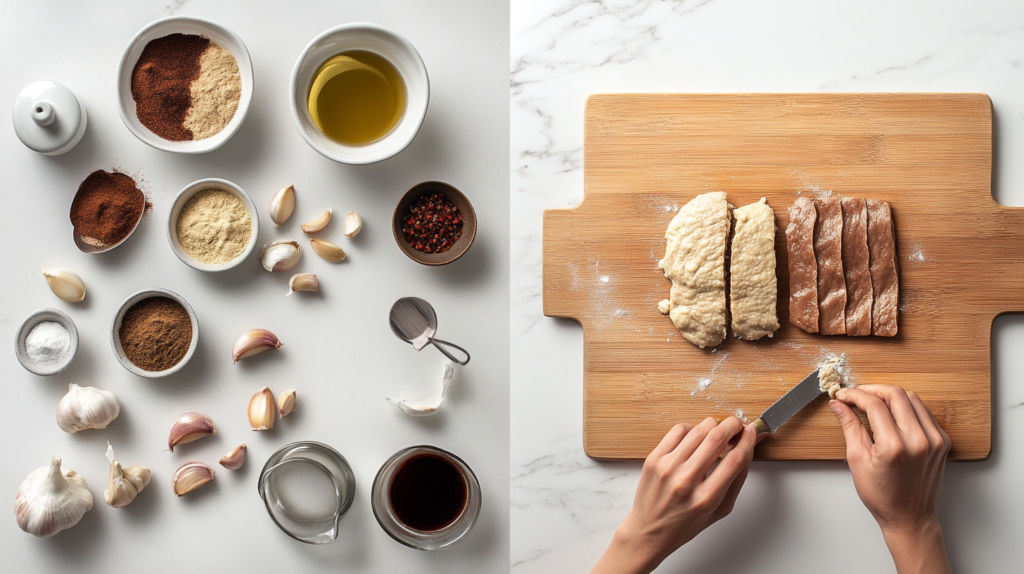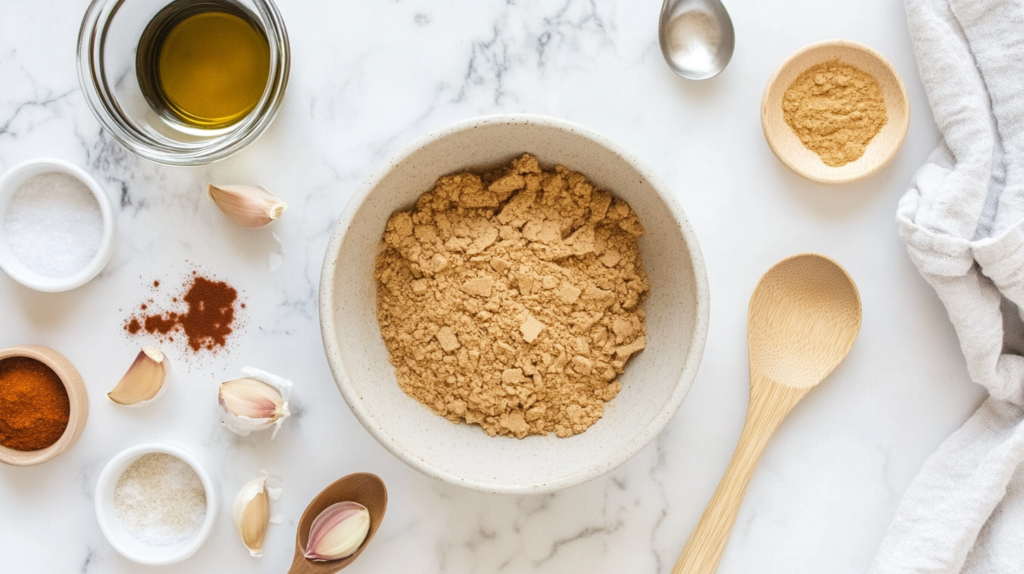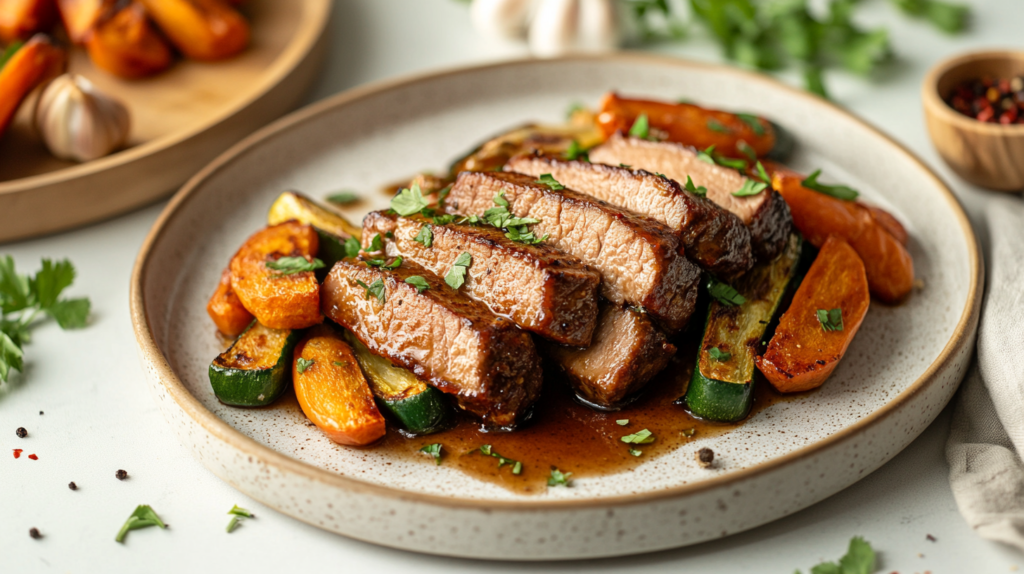If you’re on a plant-based journey or simply exploring meat-free alternatives, seitan might just become your new kitchen staple. It’s hearty, protein-rich, and has a surprisingly meaty texture that satisfies even the most devout carnivores. Best of all, it’s incredibly versatile—great for stir-fries, sandwiches, barbecues, stews, and more.
This comprehensive guide will walk you through everything you need to know about seitan—from what it is, to how to cook it, and of course, how to use it in amazing recipes. Whether you’re a vegan, vegetarian, or just experimenting with plant-based meals, there’s something here for you.
Introduction: Why Seitan Is a Must-Have in Every Plant-Based Kitchen
Let’s be honest—seitan isn’t the most inviting name. But don’t let that throw you off. Pronounced “say-tan,” this wheat-based protein is one of the best meat alternatives out there.
So, why is seitan a favorite in vegan and vegetarian kitchens?
- It’s incredibly high in protein
- It has a firm, chewy texture similar to meat
- It can be grilled, sautéed, baked, or fried
- It absorbs flavors and marinades exceptionally well
Think of seitan as a blank canvas—it becomes whatever you season it to be. With the right spices, sauces, and techniques, it can rival any traditional meat dish.
“Think of seitan as a blank canvas—one that transforms into something bold, juicy, and totally mouthwatering with the right ingredients.”
What Is Seitan? A Quick Look at the Star Ingredient

Seitan is made from vital wheat gluten—the protein-rich part of wheat. When the starch is washed away from wheat flour, what’s left is a stretchy, elastic dough that becomes the base for seitan.
This ingredient has a long history, especially in Asian cuisines. Buddhist monks have used it for centuries as a plant-based protein. Today, it’s gaining global popularity for its ability to mimic meat in both taste and texture.
When cooked correctly, seitan becomes chewy, savory, and deeply satisfying. It’s a great source of plant-based protein and makes for a fantastic meat alternative in everything from sandwiches to stir-fries.
How Is Seitan Made?
There are two primary ways to make seitan: the traditional method and the modern shortcut.
The traditional method involves rinsing flour dough under water to remove the starch. It’s effective but time-consuming. Thankfully, modern cooking has made things easier. Most people now use vital wheat gluten flour, which contains pure wheat protein.
To make seitan at home, simply combine vital wheat gluten with water or broth, knead it into a dough, and then simmer, steam, or bake it until firm. You can season the dough directly or marinate it afterward, depending on the recipe.
Seitan vs. Tofu vs. Tempeh: What’s the Difference?
These three plant-based proteins often get lumped together, but they’re quite different.
- Seitan: Made from wheat gluten. Dense and chewy. High protein. Excellent meat substitute.
- Tofu: Made from soy milk curds. Soft and versatile. Absorbs flavor well but has a milder texture.
- Tempeh: Made from fermented soybeans. Firm, nutty, and loaded with probiotics.
Each has its place in a balanced plant-based diet, but seitan is your go-to if you’re looking to replicate the texture and heartiness of meat.
“Seitan is to vegans what steak is to meat-eaters—it’s the hearty, filling centerpiece of the plate.”
Health Benefits of Cooking with Seitan
Seitan is more than just tasty—it’s also nutritionally impressive. A typical three-ounce serving contains around 20 grams of protein with very little fat or carbs. It’s a favorite among athletes and fitness enthusiasts for good reason.
In addition to its macronutrient profile, seitan is also:
- Cholesterol-free
- Low in calories
- Filling and satisfying
However, keep in mind that seitan isn’t a complete protein, meaning it doesn’t contain all nine essential amino acids. Pairing it with other protein-rich foods like legumes, grains, or nuts ensures a more balanced diet.
Is Seitan Suitable for Everyone? Allergies and Gluten Concerns
Because seitan is made entirely from gluten, it’s not suitable for people with celiac disease or gluten sensitivity. For everyone else, it’s generally considered safe, but as always, it’s best to consult your doctor or nutritionist if you’re unsure how gluten affects you.
Some people also find seitan a bit heavy on digestion, especially if eaten in large amounts or without proper preparation. If you’re new to it, start with small servings and see how your body responds.
Where to Buy or How to Make Homemade Seitan
You can find seitan at most health food stores, larger supermarkets, or specialty vegan shops. It’s typically sold in the refrigerated section, near tofu and other meat alternatives.
Buying Ready-Made Seitan: Best Brands and Stores
Popular brands include:
- Upton’s Naturals
- Tofurky
- Sweet Earth
- Field Roast
These come pre-seasoned and ready to heat—great for busy nights or quick lunches.
DIY Seitan: Simple Homemade Recipe for Beginners
Making your own seitan is not only cost-effective but also allows you to control the flavor and texture.
Here’s a quick beginner’s recipe:
Ingredients:
- 1 cup vital wheat gluten
- 3/4 cup water or veggie broth
- 1 tablespoon soy sauce
- 1/2 teaspoon garlic powder
- 1/2 teaspoon onion powder
Instructions:
- Mix dry ingredients in a bowl.
- Add liquid and stir until a dough forms.
- Knead for 2–3 minutes, then let it rest.
- Cut into pieces and simmer in seasoned broth for 30–40 minutes.
Let it cool before using in your favorite recipes.
Basic Cooking Techniques for Seitan
The beauty of seitan lies in its flexibility. You can prepare it in several ways, depending on the texture and flavor you’re after. From soft and tender to crispy and chewy, seitan can be adapted for virtually any dish.
Boiling, Baking, or Steaming: Which Method Is Best?
The first step in mastering seitan is understanding how to cook it properly. Each method creates a slightly different texture.
- Boiling or simmering: This is the traditional way to cook seitan, especially when starting with raw homemade dough. Be sure to simmer gently—if the water boils too vigorously, it can make the seitan spongy or rubbery. A slow simmer results in a soft, chewy texture that’s ideal for stews and stir-fries.
- Steaming: If you’re aiming for a firmer, meatier texture, steaming is the way to go. It cooks the seitan thoroughly while keeping it dense, making it perfect for slicing into steaks or pan-frying later.
- Baking: Baking seitan gives it a slightly crispy outer crust while keeping the inside chewy. This method is ideal for recipes like BBQ seitan ribs, meatballs, or roasts.
Each method serves a different purpose, so the right one depends on the recipe you’re planning. Don’t be afraid to experiment and see what works best for your cooking style.
Seasoning Tips: How to Infuse Flavor into Seitan
On its own, seitan has a very mild taste—some might even call it bland. But that’s actually its greatest strength. Like tofu, seitan takes on the flavors you give it, making it incredibly versatile.
Here’s how to boost its flavor:
- Season the dough: If you’re making seitan from scratch, don’t forget to add dry spices directly into the flour mix. Garlic powder, onion powder, paprika, cumin, nutritional yeast, and soy sauce can make a big difference.
- Use a flavorful broth: Instead of boiling in plain water, simmer your seitan in a well-seasoned broth. Add soy sauce, vegetable bouillon, bay leaves, peppercorns, and a splash of vinegar to create depth.
- Marinate after cooking: Just like meat, cooked seitan benefits from marination. Let it soak in teriyaki sauce, BBQ sauce, lemon-garlic dressing, or your favorite curry sauce for at least 30 minutes before reheating.
“The trick to great seitan isn’t just how you cook it—it’s what you cook it in and how long you let those flavors soak in.”
Classic and Creative Seitan Recipes You’ll Love

Now that you know the basics, let’s talk about the fun part: turning seitan into delicious meals. Whether you’re cooking for yourself, your family, or skeptical meat-eaters, these recipes are guaranteed to please.
Easy Seitan Stir-Fry
A simple stir-fry is one of the easiest and most satisfying ways to enjoy seitan.
Ingredients:
- Sliced seitan (pre-cooked or store-bought)
- Bell peppers, onions, broccoli, carrots
- Soy sauce, garlic, ginger
- Sesame oil or vegetable oil
Instructions:
- Heat oil in a wok or skillet.
- Add garlic and ginger, stir for 30 seconds.
- Add vegetables and stir-fry until just tender.
- Add seitan and soy sauce, cooking until browned.
- Serve with rice or noodles.
This is a weeknight favorite that comes together in under 30 minutes.
How to Meal Prep with Seitan for the Week
One of the best things about seitan is how well it fits into a weekly meal prep routine. Once cooked, it stores beautifully and can be used in a variety of dishes throughout the week.
Storage Tips: Fridge vs. Freezer
In the fridge: Cooked seitan will last about 5 to 7 days when stored in an airtight container. To keep it moist, store it with a bit of broth or sauce.
In the freezer: Seitan freezes very well. Slice it into meal-sized portions, wrap them tightly in foil or reusable bags, and freeze for up to 3 months. To thaw, place it in the refrigerator overnight or reheat gently in a pan with a bit of oil or broth.
Freezing homemade seitan after cooking helps preserve its flavor and texture, and it makes it easy to grab and go when you need a quick meal.
Best Reheating Methods for Texture
Avoid microwaving seitan if you want to keep it chewy and flavorful. Instead, use:
- A skillet: Sauté with a little oil to restore the crispiness.
- Oven or toaster oven: Reheat in a covered dish with a splash of broth for moisture.
- Steam basket: Works well for softer dishes like curries or stews.
Reheating low and slow helps maintain its texture without drying it out.
Common Mistakes When Cooking Seitan (And How to Fix Them)
Even though seitan is simple once you get the hang of it, there are a few common mistakes that can throw off your dish. Here’s how to fix them.
Why Is My Seitan Too Chewy or Spongy?
This usually happens when the seitan is over-kneaded or boiled too aggressively.
Solutions:
- Knead the dough just until combined. Overworking it develops too much gluten.
- If simmering, keep the liquid just below a boil. A rolling boil will puff it up and ruin the texture.
Fixing Bland or Overly Salty Seitan
Bland seitan means the seasoning didn’t go deep enough, while salty seitan might be from overdoing soy sauce or broth.
Solutions:
- Add dry seasonings directly to the dough before cooking.
- Use a flavorful broth, but dilute salty ingredients.
- Marinate the seitan after cooking for better absorption.
Overcooked or Undercooked Seitan: What to Do
If it’s too soft or raw in the middle, it likely needed more time to steam or bake.
Fixes:
- Slice it and return to heat (bake or steam until firm).
- Next time, use a thermometer—cooked seitan should reach 160–165°F internally.
“Great seitan is about balance—don’t rush the process, and let the flavor build from the inside out.”

FAQs About Seitan Recipes
Still curious? Here are answers to some of the most common seitan-related questions.
Is Seitan Good for Weight Loss?
Yes, it can be. Seitan is high in protein and low in fat, which makes it filling and satisfying without being calorie-dense. It’s a great option for lean meals, especially when paired with vegetables and whole grains.
Can Kids Eat Seitan?
Absolutely. As long as they don’t have a gluten allergy, seitan is a safe, nutritious protein source for kids. Just watch the sodium levels in store-bought versions or use low-sodium broth when making your own.
Does Seitan Taste Like Meat?
It depends on how you cook and season it. The texture is surprisingly close to meat, especially when seared or baked. With the right marinade and preparation, seitan can taste like chicken, beef, or even sausage.
It’s not an exact match, but many people find it satisfies their cravings in a healthy, plant-based way.
More Wholesome & Creative Dishes to Explore
Enjoyed experimenting with these Seitan Recipes? Keep your plant-powered creativity flowing with these flavorful and nutritious dishes available on Call Me Recipes:
- Balance your meal with the refreshing and nutritious Mashed Avocado, a perfect side or toast topper.
- Want more versatile greens? These Spinach Pesto Recipes are light, flavorful, and work great with pasta or sandwiches.
- Give your grain game a boost with the Lentil Bread Recipe — high in protein and fiber.
- Add variety to your wraps or stir-fries with these creative Rice Paper Recipes — light, gluten-free, and fully customizable.
- Pack your plate with veggie goodness using Cottage Cheese Recipes — great for snacks or quick meals.
- Upgrade your mornings with Cottage Cheese and Egg Recipes — protein-packed and meal-prep friendly.
- Explore bold, Filipino flavor with a plant-based twist using the Sinigang Recipe — tangy, comforting, and adaptable.
- Make your breakfast sweet but smart with Low-Sugar Dessert Recipes that won’t derail your healthy habits.
- Want a satisfying warm dish? Try this Purple Sweet Potato Recipe for a colorful, nutrient-rich option.
These recipes make excellent companions to seitan — whether you’re after high-protein meals, globally inspired dishes, or health-conscious sides. Explore more on Call Me Recipes to keep your kitchen fresh and flavorful!
Final Thoughts: Why Seitan Belongs in Your Weekly Menu
Seitan is more than just a meat alternative—it’s a reliable, versatile, and protein-rich ingredient that can easily become the heart of your weekly meals. Whether you’re trying to reduce meat, explore vegan cooking, or just enjoy something new, seitan offers endless possibilities.
It’s easy to prepare, stores well, and adapts to nearly any flavor profile. From crispy nuggets and BBQ ribs to hearty curries and stir-fries, you’ll never run out of delicious ways to use it.
So go ahead—give seitan a spot on your grocery list or make a batch at home. Once you start cooking with it, you’ll wonder how you ever got by without it.
“Seitan isn’t just for vegans—it’s for anyone who loves good food, big flavors, and a little creativity in the kitchen.”

